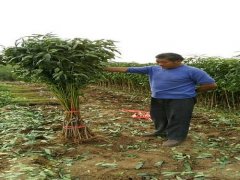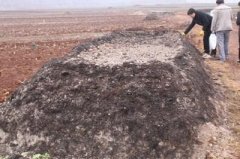How to use compost: what are the benefits of composting?
Do you know the benefits of composting? The source of nutrients for organic crops depends entirely on the use of compost under the principle of no use of chemical fertilizers. The nutrient content of compost, except for a small amount of rapidly available inorganic nutrients, most of the nutrients need to be mineralized before they can be released. The rate of mineralization is limited by climate, season, moisture, and soil properties, which may not provide crop growth needs in time. Therefore, the application of compost with high available nutrients, such as Birkassi fertilizer or liquid organic fertilizer, can supply crop nutrient needs immediately.
The application of compost has three effects on organic farming: (1) supplying crop nutrients, (2) improving soil physical and chemical properties, and (3) activating soil.
The effects of these three effects on field crops occurred sequentially.
At the initial stage of organic farm management, composting was mainly based on nutrient supply. after 5-6 years of operation, the soil properties would be significantly improved, and the effect of increasing production began to appear. Ten years later, the soil in the organic field was activated, and even showed the effect of static bacteria and disease resistance. In order to achieve all the above effects of composting, organic farm management requires long-term perseverance and continuous efforts.
After long-term application of compost in farmland, the soil properties will change gradually. First of all, the soil PH value, EC value, base saturation, organic matter content and cation exchange energy will slowly increase, and soil aggregates will gradually form, resulting in the decrease of soil hardness and overall density, and the soil quality will be gradually loosened and easy to cultivate. In the case of the increase of organic matter content, the soil microorganisms are diversified, multiply in large numbers, the soil activity is enhanced, the buffer capacity to harmful substances is enhanced, the mineralizable nutrients are also relatively increased, and the yield-increasing effect on crops is gradually obvious. during this period, if the field is managed properly, the yield can be increased by about 10-30%.
However, if the compost is not applied properly, the soil properties will also have a negative reaction in the long run. For example, too much application of Berkassi fertilizer results in too high EC and phosphorus; too much application of calcareous chicken manure compost results in too high content of PH, EC, phosphorus, potassium, calcium and magnesium; long-term application of plant compost made of rice straw, weeds, and fallen leaves results in low PH and lack of phosphate; and long-term application of pig manure compost results in too high content of heavy metals in the soil. When the content of phosphorus in the soil is high, the base saturation is high, and PH is alkaline, just like the elderly, who are obese and have the risk of hypertension, soil productivity will be poor. Therefore, the deviation of fertilization can be understood by monitoring the physicochemical property of soil from time to time. In general, after long-term and careful soil cultivation, healthy organic dry fields have a range of soil properties, the PH value is neutral, the EC value is about 0.2-0.6 ms/cm, the base saturation is 60-90%, the calcium-magnesium equivalent ratio is less than 6, the magnesium-potassium equivalent ratio is above 2, the soil density is 10-20 mm by Yamanaka hardness meter, the crude porosity is less than 15%, and the content of heavy metals meets the farmland standard. If the soil properties exceed this range, it is necessary to carry out soil improvement, especially the fertilization adjustment based on nutrient balance.
There is a demonstration field in the south of this field. after 12 years of organic cultivation, the soil properties have been significantly improved compared with the control chemical area, as shown in Table 1. As for its effect on yield, taking the tender stem lettuce in the autumn of 1987 as an example, the yield in the organic area was 55% higher than that in the chemical area, and in the spring of 1989, the yield in the organic zone was 22% higher than that in the chemical zone. However, the soil properties in this area are at the critical edge of high soil fertility after long-term application of pig manure and cow manure compost, and needs to be further reduced.
The third effect of composting is that after soil activation, it has the ability of static bacteria and disease inhibition. The so-called static bacteria and disease inhibition ability means that when the pathogenic bacteria enter the crop rhizosphere, the rhizosphere microorganisms have the defense force to prevent the spores from sprouting or inhibit their reproduction, so as to protect the crop roots from damage. Taking the organic demonstration field in Qinan Branch as an example, when it was used as tender stem lettuce in the autumn of 1987, the yield in the organic area increased by 55%, partly due to the occurrence of 12% stem rot in the control area, while almost no occurrence in the organic area. Thus it can be seen that the demonstration field has the ability to restrain the disease only after 12 years of efforts.
Soil has the ability to inhibit disease, in addition to long-term cultivation of soil, the most important reason is through the long-term application of good soil compost to provide a stable food source, completely change the soil microbial phase, and induce a large number of beneficial and orange anti-microbial reproduction, so as to achieve the effect of disease inhibition.
By analogy, all field operations that can provide a good soil environment, supply microbial nutrients, and improve the living environment of soil microorganisms can be regarded as the first step in the cultivation of disease-suppressing soil. Therefore, field operations, such as deep ploughing, planting of green manure, improvement of drainage, application of good compost, rotation, mixed cropping, intercropping and mulching, can help to achieve the above objectives earlier.
- Prev

What is organic matter in fertilizer? What are the types of organic matter in fertilizer?
Organic fertilizer selection and application technology, do you know if you don't know, then take a look at this article, understand it. This will allow for better crop fertilization. Selection according to soil conditions can be based on soil samples sent to the improvement site for analysis of soil organic matter
- Next

Organic fertilizer production method: weeds make organic fertilizer, what are the benefits of weeds making organic fertilizer?
Weed organic fertilizer: weeds can also be made into organic fertilizer. Do you know how to make them? Only by farming from a longer-term perspective and forming a cycle of good, can the vitality of the earth last forever. In the general concept of farmers, weeds are not good, it
Related
- Fuxing push coffee new agricultural production and marketing class: lack of small-scale processing plants
- Jujube rice field leisure farm deep ploughing Yilan for five years to create a space for organic food and play
- Nongyu Farm-A trial of organic papaya for brave women with advanced technology
- Four points for attention in the prevention and control of diseases and insect pests of edible fungi
- How to add nutrient solution to Edible Fungi
- Is there any good way to control edible fungus mites?
- Open Inoculation Technology of Edible Fungi
- Is there any clever way to use fertilizer for edible fungus in winter?
- What agents are used to kill the pathogens of edible fungi in the mushroom shed?
- Rapid drying of Edible Fungi

